What Makes This 1990s Yamaha Stand Out from the Crowd?
You might be wondering why anyone would get excited about a garishly painted Yamaha from the 1990s, especially one that looks like it’s been through a few too many mud puddles. But here’s the thing: beneath those bold graphics and a few battle scars lies a machine with real character. Bikes from this era, especially the so-called “dirtbag” models, have a reputation for being nearly indestructible, endlessly customizable, and—let’s be honest—a total blast to ride.
The 1990s were a wild time for motorcycle design. Manufacturers weren’t afraid to experiment with neon colors, wild patterns, and aggressive styling. This Yamaha is a perfect example. It’s not just about looks, though. These bikes were built to last, with simple, robust engineering that makes them ideal for tinkerers and track-day enthusiasts alike.
Why Would Anyone Pay $500 for a Beaten-Up Yamaha?
At first glance, dropping $500 on a tired old Yamaha might seem like a questionable investment. But for many riders, that’s exactly the appeal. You’re not buying a pristine collector’s item—you’re getting a blank canvas. With a little elbow grease and creativity, you can transform a neglected machine into something truly unique.
There’s also a practical side. Older Yamahas are known for their reliability and ease of maintenance. Parts are usually cheap and readily available, and the basic mechanicals mean you don’t need a degree in engineering to keep them running. For someone looking to build a dedicated track bike without breaking the bank, this kind of project makes perfect sense.
How Do You Turn a Neglected Bike into a Track-Only Machine?
Turning a $500 Yamaha into a track weapon isn’t about throwing money at it. It’s about making smart, targeted upgrades. Start by stripping off any unnecessary weight—fairings, lights, and mirrors can all go. Next, focus on safety: fresh tires, new brake pads, and a thorough check of the suspension are musts.
From there, it’s about dialing in the details. Swap out worn controls, upgrade the exhaust for a little extra punch, and maybe even tweak the gearing to suit your local track. The beauty of these older bikes is that you can experiment without fear. If you drop it in a corner, you’re not ruining a priceless classic—you’re just adding another story to its already colorful history.
What’s the Real Value in Restoring and Riding Old Motorcycles?
There’s something deeply satisfying about breathing new life into a machine that others have written off. It’s not just about saving money, though that’s certainly a perk. It’s about learning new skills, building confidence, and joining a community of like-minded enthusiasts who appreciate the quirks and charms of vintage bikes.
Recent studies from the Motorcycle Industry Council show that DIY projects are on the rise, with more riders than ever choosing to restore and modify older bikes instead of buying new. This trend isn’t just about nostalgia—it’s about sustainability, creativity, and the thrill of making something your own.
What Surprises Await When You Take a 1990s Yamaha to the Track?
You might expect an old Yamaha to feel sluggish or outdated on the track, but that’s rarely the case. These bikes often surprise their riders with nimble handling and a playful character that’s hard to find in modern machines. Sure, they might lack the raw horsepower of today’s superbikes, but they make up for it with a sense of connection and fun that’s tough to beat.
There’s also a certain freedom that comes with riding a bike you’ve built yourself. Every lap is a chance to test your handiwork, tweak your setup, and push your limits. And when you finally nail that perfect corner, the sense of accomplishment is unbeatable.
A Fresh Perspective on Old Bikes
The big takeaway? Turning a $500 “dirtbag” Yamaha into a track-only bike isn’t about perfection—it’s about smarter adjustments. Start with one change this week, and you’ll likely spot the difference by month’s end. Sometimes, the most memorable rides come from the most unexpected places.


